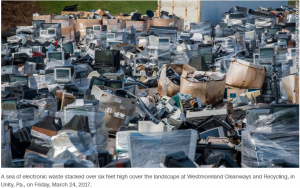If you’re like many people, you’ve accumulated a drawer full of old gadgets and wires. However, this isn’t just an accident: The tech sector’s demand for rapid innovation has led to a long list of useful and flashy household products. However, many of these same devices have little longevity, Basel Action Network so they must be replaced at almost the same rapid rate that new technology emerges. The result of this so-called planned obsolescence is a tsunami of electronic waste—more commonly known as e-waste—that extends beyond the headache of figuring out what to do with the clutter tucked away inside your home.
The latest United Nation’s information shows the world created a stunning 53.6 million metric lots of e-squander in 2019, and just 17.4% of that was reused. The weight and damages of e-squander frequently tumble to those in non-industrial nations. The US Environmental Protection Agency appraises that an “unsure measure of utilized gadgets is transported from the United States and other created nations to agricultural nations that come up short on ability to dismiss imports or to suitably deal with these materials.”
The World Health Organization (WHO) cautioned last year that the removal and handling of taking off e-waste can cause a scope of “unfriendly youngster wellbeing influences,” remembering changes for lung capability, DNA harm and expanded hazard of a few constant sicknesses like malignant growth and cardiovascular illness sometime down the road.
Also, there are in excess of 18 million youngsters and teenagers “effectively locked in” in the casual e-squander handling industry, the WHO cautioned. Kids and teenagers are in many cases used to scour through piles of e-squander looking for significant materials like copper and gold “in light of the fact that their little hands are more skillful than those of grown-ups,” the WHO said.
The issue of e-squander is “about natural equity at the worldwide level,” Puckett said. “It’s tied in with holding the rich nations back from unloading their waste and messy advances on agricultural nations.”
The developing natural emergency is presently grabbing the eye of legislators from Europe to the United States, as well as networks in the agricultural countries where e-squander has generally been offshored.
EU authorities last month endorsed another regulation requiring all telephones and gadgets to utilize a norm, brand-skeptic charger, with the possibility to restrict the number of various wires the typical customer that necessities to possess. Three moderate American officials encouraged in a letter for the US to follow after accordingly.
Sens. Ed Markey, Elizabeth Warren and Bernie Sanders said the clever EU strategy “can possibly fundamentally diminish e-waste and help customers who are fed up with scavenging through garbage drawers brimming with tangled chargers to see as a viable one, or purchase another one,” in a letter addressed to the US Commerce secretary. The congresspersons suggested the bipartisan hotly debated issue of “taking on strong innovation organizations” in light of a legitimate concern for customers and the climate.
For the time being, however, guideline around e-squander exists basically at the state level and there are not many indications of government strategy pushing ahead sooner rather than later. In its nonappearance, the onus keeps on being on customers – – and organizations – – to step up and track down better ways of managing old gadgets.
What shoppers and organizations can do about it
At the point when Corey Dehmey worked in corporate IT divisions, he needed to sort out how to manage many organization PCs that were presently not cutting-edge. Presently, as chief overseer of non-benefit Sustainable Electronics Recycling International (SERI), he is important for a gathering attempting to handle the e-squander emergency by supporting participation between the public authority, confidential area and customers.
“E-squander is the consequence of not making arrangements for the item all through its lifecycle,” Dehmey said. “We’re simply responding to an issue we made quite a while back. Thus to get before this thing, we need to ponder these things toward the front – – what we’re planning and what we as buyers are buying also.”
That’s what to do, SERI presented and supervises its own accreditation principles for e-squander reusing that ensures offices are appropriately discarding e-squander. It likewise has occasions for organizations and different partners and participates in support work to compel organizations and legislatures to adopt more manageable strategies to creating hardware.
“We must sort out ways of utilizing [an electronic device] longer, fix it, reuse it,” Dehmey said, noticing this will require attitude shifts from the two buyers and organizations.
Lately, there has been a purpose for hopefulness on this front. The flood in e-squander has prompted expanded strain on producers to ease limitations on fixing gadgets for people and free fix shops in a push known as the “right to fix” development. President Joe Biden last year passed a leader request that guided the Federal Trade Commission to give rules expecting organizations to permit DIY fixes, and the FTC promised to “root out” unlawful fix limitations.
Presently, a modest bunch of tech organizations have sent off drives to assist with fixing old devices. Recently, Apple and Samsung sent off their self-administration fix stores, offering parts for clients looking for DIY fixes for their cell phones. Google also guaranteed parts for fixing Pixel telephones will be accessible to the public in the not so distant future.
Different alliances have likewise arisen as of late to give shoppers the choice to discard their gadgets capably. Puckett helped send off the e-squander reusing drive e-Stewards, for instance, which guarantees and reviews hardware recyclers to ensure they are appropriately discarding e-squander utilizing “exceptionally thorough norms.”
With this device, buyers can look into neighboring reusing focuses. SERI likewise offers an internet based instrument to find a guaranteed reusing focus.
Jeff Seibert, the central provocateur (indeed, that is his genuine title) at SERI, likewise suggests buyers check with their neighborhood region to check whether they have an assigned arrangement for reusing e-squander. A modest bunch of US retailers, including Staples and Best Buy, likewise have programs that let customers get e-squander for reusing without a trace of more extensive foundation. Different organizations, including Apple, bring projects to the table for credits or free reusing in return for exchanging utilized devices.
Prior to selecting to give or reuse utilized gadgets, the EPA suggests considering redesigning the equipment or programming of a PC as opposed to purchasing a spic and span item. Assuming you really do choose to reuse, the EPA urges customers to eliminate any batteries that might should be reused independently. The organization says that reusing 1,000,000 workstations saves what could be compared to the power utilized by in excess of 3,500 US homes in a year. For each 1,000,000 cells that are reused, the organization says 35,000 pounds of copper, 772 pounds of silver, 75 pounds of gold and 33 pounds of palladium can be recuperated.
Aside from these choices, Seibert basically encourages customers to begin pondering hardware like we contemplate vehicles: we don’t waste our vehicles when we really want new tires or on the other hand assuming the windshield breaks.
“Everyone believes should make the best choice,” Seibert said. “So we must give them the assets to have the option to do that, that is as yet a work underway.”







